
We
have a summer house at a lake in the Rhein valley. When
I have the opportunity to spend some time there, I usually
setup a little portable station to operate mostly on
10m and 15m in SSB as well as on VHF/UHF in FM and SSB.
From my station I have a nice view over the lake. |
    
|

|
The pictures below show the house
with the 3 antennas, which are presently installed:
a
Diamond X5000: this is a tri-band 2m/70cm/23cm vertically
polarized stacked omni-directional antenna.
VHF-Eggbeater
antenna: this is an omni-directional antenna which
is circularly polarized towards zenith (optimum
for the reception of weather satellites at 137 MHz)
and horizontally polarized in the direction of the
horizon (optimum for 2m SSB).
a
W-210 from WIMO: this is a tri-band HF trap
dipole for 10m/15m/20m. You can barely see the wire
but only the 2 traps on each side of the dipole.
|
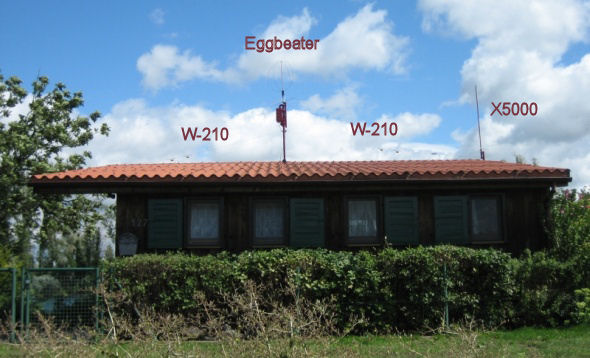
|
As you can see the horizontally polarized
HF dipole is placed very close to the top off the roof.
Usually you would expect that it needs to be mounted
much higher, however as the house is made of wood the
antenna still works nicely and when the 10m band is
"open" very nice contacts all over Europe
are possible. You can see in the reports further below
on this page, so far most contacts on
HF were with stations east of the summer house. I am
not sure whether this is due to the fact that the lake
is east of the house and therefore my antenna works
best in that direction or simply that the general propagation
conditions towards east were more favorable. Probably
it is also true that more stations in the eastern part
of Europe were active during those times. More trials
have to check this. |
To
complement this portable station I usually bring my
YAESU FT-726 transceiver from home, which covers the
bands: 15m, 12m, 10m, 2m, 70cm. For reception of the
other HF bands I used to have a YAESU FRG-7700 receiver,
which I meanwhile sold. To receive the weather satellites
on VHF I use an ICOM PCR-100 black-box receiver which
is controlled by a laptop. The laptop also runs the
software for decoding and visualizing the weather pictures. |
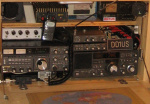
|
Finally
I am planning to setup an APRS beacon at the summer
house, possibly together with a weather station. Recently
I acquired a second hand ICOM IC-T8A and already assembled
an OpenTracker module. Stay tuned for the completion
of this little project. |
|

In
the summer of 2006 I operated the /p station during
a short opening of the 10m band on August 9th. With
only 10 Watt output power I could talk to stations from
24 different countries. Please see the table below as
well as the maps with the contacts:
9A
Croatia
DA-DL Fed.
Rep. of Germany
EA-EH Spain
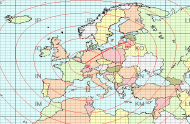 EU,
EV, EW Belarus EU,
EV, EW Belarus
F France
G, GX England
GM, GS Scotland
HA, HG Hungary
I Italy
LA-LN Norway
LZ Bulgaria
OE Austria
OF-OI Finland
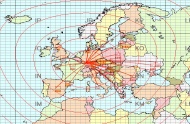 OK-OL
Czech
Republic OK-OL
Czech
Republic
OZ Denmark
S5 Slovenia
SA-SM Sweden
SN-SR Poland
SV-SZ Greece
UA-UI1,3,4,6 European Russia
UR-UZ,
EM-EO Ukraine
YL Latvia
YO-YR Romania
YT-YU, YZ Serbia
& Montenegro |

Also
in August of 2007 I operated the /p station during another
opening of the 10m band. Luckily the opening just happened
when we had 5 days of bad weather and thus it was a
fun way to make use of the time. During the winter before
I had refurbished a surplus 11m band power amplifier
which allowed me to use this time 50 Watt output power.
Between August 4th and 9th I worked more than 50 stations
from 24 different countries. Please see the table below
as well as the maps with the contacts:
9A
Croatia
DA-DL Fed.
Rep. of Germany
EA-EH Spain
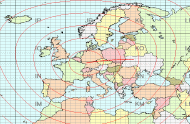 ER
Moldovia ER
Moldovia
EU, EV, EW Belarus
F France
G, GX England
HA, HG Hungary
I Italy
LA-LN Norway
LY Lithuania
LZ Bulgaria
OF-OI Finland
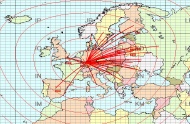 OH0
Aland
Is. OH0
Aland
Is.
OM Slovak
Republic
OZ Denmark
SA-SM Sweden
SN-SR Poland
T9 Bosnia-Herzegovina
UA-UI1,3,4,6 European Russia
UA2 Kaliningrad
UR-UZ, EM-EO Ukraine
YL Latvia
YO-YR Romania |

In
September 2007 I operated the /p station during a 2m
contest. I used the 2m Eggbeater omnidirectional antenna
which is horizontally polarized. I worked 57 stations
from 25 different squares (see the picture below). The
greatest distance bridged was to a station in UK which
was 584km away. I worked stations from the following
10 different countries:
DA-DL Fed.
Rep. of Germany
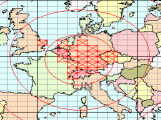 F
France F
France
G, GX England
HB Switzerland
LX Luxembourg
OE Austria
OK-OL Czech
Republic
ON-OT Belgium
PA-PI Netherlands
SN-SR Poland |

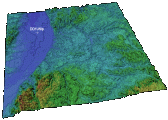
|
As
you can see in the picture to the left our summerhouse
is located in the centre of the Rhein valley. As the
valley is flat I can reach quite a number of repeaters
mostly on 2m and 70cm band. If you want to contact me
via one of the repeaters, chances are best to reach
me on 2m via DB0ZH, DB0VD or DB0XK. On 70cm band I am
sometimes monitoring DB0ND, DB0UU, DB0MA, DB0RO or DB0NP.
On 23cm band I can only reach a single repeater which
is DB0RO. |
10m FM repeaters
Channel
No. |
Output
/ Input QRG
in MHz |
QTH |
Call
sign |
QRA
locator |
QRB
/ distance |
KW2 |
A29.670/E29.570 |
Feldberg/Taunus |
DB0FT |
JO40FF |
93
km |
KW4 |
A29.690/E29.590 |
Ludwigsburg |
DF0LBG |
JN48OV |
78
km |
2m FM repeaters
Channel
No. |
Output
/ Input QRG
in MHz |
QTH |
Call
sign |
QRA
locator |
CTCSS |
QRB / distance |
RV48 |
A145.600/E145.000 |
Feldberg/Taunus |
DB0FT |
JO40FF |
|
93 km |
RV49 |
A145.61250/E145.0125 |
Valsberg/Strasbourg |
F5ZAU |
JN38OI |
|
148 km |
RV50 |
A145.625/E145.025 |
Heidelberg |
DB0ZH |
JN49IJ |
|
18 km |
RV52 |
A145.650/E145.050 |
Pforzheim |
DB0UP |
JN48IV |
|
59 km |
RV52 |
A145.650/E145.050 |
Pirmasens |
DB0VP |
JN39TE |
|
65 km |
RV53 |
A145.6625/E145.0625 |
Darmstadt/Melibokus |
DB0VD |
JN49HR |
|
39 km |
RV54 |
A145.675/E145.075 |
Karlsruhe |
DB0UK |
JN48EX |
94.8Hz |
47 km |
RV55 |
A145.6875/E145.0875 |
Hohe
Brach |
DB0PE |
JN49SB |
|
87 km |
RV56 |
A145.700/E145.100 |
Kalmit |
DB0XK |
JN49BH |
|
26 km |
RV58 |
A145.725/E145.125 |
Wissembourg |
F5ZCO |
JN39WA |
|
59 km |
RV60 |
A145.750/E145.150 |
Frankfurt/Main FMT |
DB0HTV |
JO40HD |
|
84 km |
RV62 |
A145.775/E145.175 |
Böllstein |
DB0VB |
JN49LR |
|
52 km |
RV63 |
A145.7875/E145.1875 |
Hoherodskopf |
DB0HK |
JO40OM |
|
126 km |
70cm FM repeaters
Channel
No. |
Output
/ Input QRG in MHz |
QTH |
Call
sign |
QRA
locator |
QRB / distance |
RU690 |
A438.625/E431.025 |
Feldberg/Taunus |
DB0FT |
JO40FF |
93 km |
RU692 |
A438.650/E431.050 |
Heilbronn |
DB0HN |
JN49OD |
61 km |
RU694 |
A438.675/E431.075 |
Bruchsal |
DB0RB |
JN49HC |
35 km |
RU698 |
A438.725/E431.125 |
Donnersberg |
DB0ND |
JN39VP |
56 km |
RU700 |
A438.750/E431.150 |
Feldberg/Taunus |
DB0FT |
JO40FF |
93 km |
RU702 |
A438.775/E431.175 |
Ortenau/Renchtal |
DB0ORT |
JN48BN |
96 km |
RU702 |
A438.775/E431.175 |
Idstein/Taunus |
DB0IDS |
JO40DF |
93 km |
RU704 |
A438.800/E431.200 |
Darmstadt/Melibokus |
DB0UU |
JN49HR |
39 km |
RU710 |
A438.875/E431.275 |
Karlsbad/Ittersbach |
DB0XQ |
JN48HV |
57 km |
RU716 |
A438.950/E431.350 |
Karlsruhe |
DB0UX |
JN48EX |
47 km |
RU717 |
A438.9625/E431.3625 |
Hambach/Maxburg |
DO0ACR |
JN49BH |
26 km |
RU718 |
A438.975/E431.375 |
GrossUmstadt |
DB0IO |
JN49LU |
62 km |
RU720 |
A439.000/E431.400 |
Leistadt/Bad
Dürkh. |
DB0NIX |
JN49BL |
26 km |
RU722 |
A439.025/E431.425 |
Mannheim |
DB0MA |
JN49GL |
11 km |
RU729 |
A439.1125/E431.5125 |
Kaiserslautern |
DB0KLN |
JN39VK |
48 km |
RU730 |
A439.125/E431.525 |
Landau |
DB0RO |
JN49AF |
35 km |
RU732 |
A439.150/E431.550 |
Sinsheim |
DB0NP |
JN49KF |
35 km |
RU735 |
A439.1875/E431.5875 |
Langenbrand |
DB0LAB |
JN48HT |
66 km |
RU746 |
A439.325/E431.725 |
Wiesb./Hohe
Wurzel |
DB0VA |
JO40BC |
82 km |
70cm DSTAR / DMR repeater
Channel
No. |
Output
/ Input QRG in MHz |
QTH |
Call
sign |
QRA
locator |
QRB / distance |
RU756 |
A439.450/E431.850 |
Feldberg/Taunus |
DB0HRF |
JO40FF |
93 km |
23cm
FM repeater
Channel
No. |
Output
/ Input QRG in MHz |
QTH |
Call
sign |
QRA
locator |
QRB / distance |
RS25 |
A1298.625/E1270.625 |
Landau |
DB0RO |
JN49AF |
35 km |
|

At
my /p QTH (portable location) I frequently use my little
SAMS (Short Amateur Message System) pager to monitor the activities on
the HF bands as well as via the satellites. SAMS is
an Amateur Radio service which is based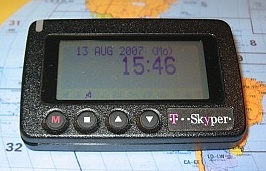 on
the POGSAC (Post Office Code Standarization Advisory
Group) standard and just as all Amateur Radio services
it is free of charge. It transmits short numeric as
well as alphanumeric messages with a data-rate of 1200bd
using FFSK modulation (Fast Frequency Shift
Keying) with a maximum deviation of 4 kHz. A standard pager (in German: Funkruf
Empfänger) needs only small modifications to be
used for SAMS. The change consists of the replacement
a few components and of a re-tuning to 439.9875 MHz,
which is the unified frequency for all SAMS transmissions
in Germany. After registering your unique device ID
in the SAMS network you can configure your SAMS to determine,
which message types you want to receive. The SAMS network
is synchronized and uses as a backbone the Packet Radio
network of the Radio Amateurs. Other ham radio amateurs
can also send me personal messages to my SAMS pager
either through the packet radio network or an Internet-to-Packet
Radio-Gateways like DB0BI
in Bielefeld or DB0FHN
in Nürnberg. Fortunately I have a good coverage
with 3 SAMS transmitters close. These are DB0CPU in
Mannheim (JN49FL), DB0FLX in Darmstadt (JN49HV) and
DB0IE in Karlsruhe (JN49EA). on
the POGSAC (Post Office Code Standarization Advisory
Group) standard and just as all Amateur Radio services
it is free of charge. It transmits short numeric as
well as alphanumeric messages with a data-rate of 1200bd
using FFSK modulation (Fast Frequency Shift
Keying) with a maximum deviation of 4 kHz. A standard pager (in German: Funkruf
Empfänger) needs only small modifications to be
used for SAMS. The change consists of the replacement
a few components and of a re-tuning to 439.9875 MHz,
which is the unified frequency for all SAMS transmissions
in Germany. After registering your unique device ID
in the SAMS network you can configure your SAMS to determine,
which message types you want to receive. The SAMS network
is synchronized and uses as a backbone the Packet Radio
network of the Radio Amateurs. Other ham radio amateurs
can also send me personal messages to my SAMS pager
either through the packet radio network or an Internet-to-Packet
Radio-Gateways like DB0BI
in Bielefeld or DB0FHN
in Nürnberg. Fortunately I have a good coverage
with 3 SAMS transmitters close. These are DB0CPU in
Mannheim (JN49FL), DB0FLX in Darmstadt (JN49HV) and
DB0IE in Karlsruhe (JN49EA). |

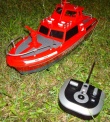
|
Sometimes
I am also operating an ultra small ATV station here
on the lake. It is a modified remote controlled toy.
Together with my daughter, who is the captain of this
boat, we added a small colour camera and FM ATV transmitter
to the fire-boat. It is fun to watch the live view from
the boat just like sitting in it. We can watch it on
the screen of a laptop placed on the lake-front while
chasing "the ducks" on the lake. |
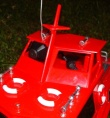
|
If
you click on the icon on the right you can see a video,
which was taken during the first trials. The boat transmits
the video signal in the 23cm Ham Radio band and the
corresponding receiver delivers a composite video signal
output. This analog signal is converted to digital by
a USB frame grabber module and then displayed and stored
on the laptop. Please note that the download of the
video file may take a moment as it is 1.5 MByte large.
A fast internet connection certainly helps here. |
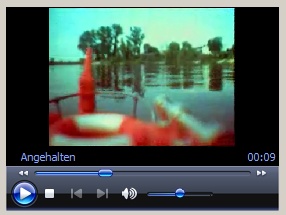
|

|
In
summer 2010 I restored an old sailing boat which I had
inherited from my father. Interestingly it was built
by him in the year when I was born and thus meanwhile
is 46 years old. It is completely built from wood and
based on a kit from Graupner called Gracia. If you click
on the picture to the left you will download a description
with more pictures which includes also the original
documents used to build this beautiful boat. |
|